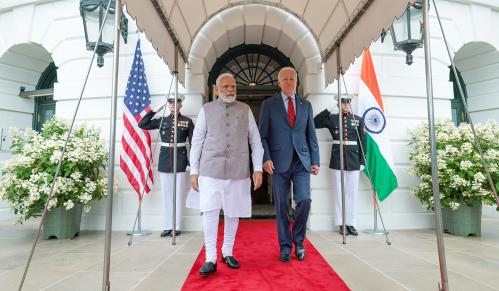EXECUTIVE SUMMARY
The U.S.-India defense and security relationship has continued to deepen, aided by robust political commitments in both countries and converging concern about growing Chinese assertiveness across the Indo-Pacific. The United States and India have expanded their defense activities and consultations, and recently concluded two additional so-called “foundational defense agreements,” capping off a nearly two-decade effort by U.S. policymakers to formalize the legal sinews of operational defense cooperation. This positive trajectory is, however, by no means guaranteed to continue apace. There are rising concerns in the United States about India’s fiscal limitations, its ties with Russia, its ponderous response to a pattern of Chinese provocations on its border, and its drift toward illiberal majoritarian politics. In addition, the Biden administration will likely seek, for good reason, to rebalance the bilateral relationship away from a disproportionate focus on security issues in order to address a wider array of topics including global health, energy and climate change, and technology cooperation.
In light of these dynamics, this paper presents a practical agenda for the next phase of the U.S.-India defense and security relationship — one that builds incrementally on the progress that has been made, responds to the changing regional security environment, and accounts for both governments’ political and capacity constraints. It begins by arguing that the United States can do more to articulate its key priorities in engaging India on security issues: first, supporting India’s rise as a constructive global leader and counterweight to Chinese influence; second, limiting China’s ability to coerce India and other states in South Asia; and third, mitigating the risks, and enabling de-escalation, of inevitable India-Pakistan and India-China crises. It also makes a case for charting reasonably ambitious defense and security goals and avoiding crude conditionalities that would likely prove counterproductive.
The paper proposes, and explores in depth, six key priorities for cooperation: 1) situating defense ties with India in a wider bilateral and multilateral architecture; 2) driving a more holistic defense planning dialogue that periodically assesses the regional threat environment, identifies capability gaps, and helps to source those capabilities to the Indian services; 3) reviewing exercises to prioritize high-end activities that could enable combined operations and low-end activities with third countries that are at risk of undue Chinese influence; 4) sustaining support for high technology cooperation and co-development efforts; 5) identifying opportunities to further institutionalize intelligence sharing; and 6) deepening consultations to mitigate emerging risks in the cyber, space, and nuclear domains.
The U.S. defense and security relationship with India is a modest but important piece of the Biden administration’s wider Indo-Pacific agenda, and one that will require steady investment and recalibration rather than major redesign. Ultimately, the administration’s defense ambitions with India will only be realized if it works to rebuild a broader bilateral relationship that is not disproportionately dependent on defense and security ties; is disciplined about setting and resourcing its Indo-Pacific priorities; is realistic about India’s constraints; and is willing to invest in high-level engagement at the leader and Cabinet levels to sustain an ambitious agenda.
-
Acknowledgements and disclosures
The author would like to thank Alyssa Ayres, Chris Clary, Lindsey Ford, Sajit Gandhi, Juzar Ghadyali, Sema Hasan, Sameer Lalwani, Peter Lavoy, Tanvi Madan, Daniel Markey, Vipin Narang, Philip Reiner, Frank Rose, Benjamin Schwartz, Vikram Singh, Jeff Smith, Paul Staniland, Richard Verma, Robin Walker, and a number of U.S. government officials for their critical feedback on earlier drafts. Ted Reinert edited this paper, and Rachel Slattery provided layout.
The Brookings Institution is committed to quality, independence, and impact.
We are supported by a diverse array of funders. In line with our values and policies, each Brookings publication represents the sole views of its author(s).







